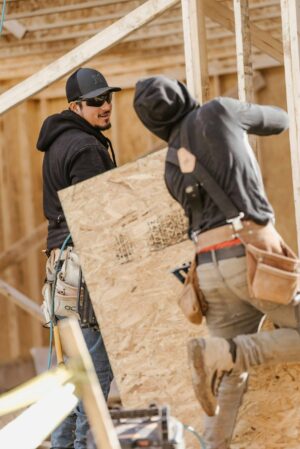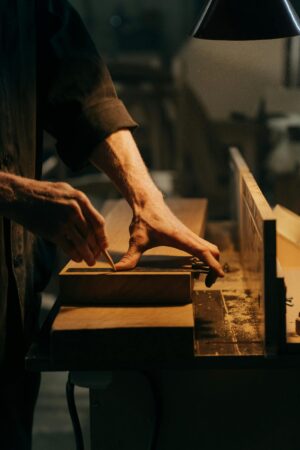Table of Contents

Framers working on a wood-framed home in Florida.
Understanding the Issue
The integrity of your home’s flooring is not just about aesthetics—it plays a crucial role in the overall comfort and safety of your living space. Bouncy and squeaky floors, common issues faced by many homeowners, can be indicative of underlying structural problems that need addressing.
Identifying Bouncy Floors
Bouncy floors are often characterized by a noticeable flex or give when walked upon. This condition can be due to several factors, including the overspanning of joists, inadequate subfloor thickness, or the deterioration of structural supports over time.
Pinpointing Squeaky Floors
Squeaky floors, on the other hand, emit noise with foot traffic and can result from a range of issues such as loosened subfloor nails, shrinking or warped floorboards, or even the natural settling of the house over time.
Why It Matters
Beyond the annoyance factor, these issues can detract from your home’s value and may even pose safety risks if left unaddressed. Understanding the root cause is the first step towards effective remediation.
Deep Dive into Bouncy Floors
Understanding the technical aspects of why floors become bouncy can empower homeowners to make informed decisions about repairs and reinforcements. Bounciness is not just an inconvenience but can be a symptom of deeper structural issues.
Joist Span and Sizing
The span of floor joists—how far they stretch between supports—plays a significant role in floor stability. When joists are spaced too far apart or are not thick enough to support the weight above, floors can feel bouncy or springy.

Measure twice, cut once.
Subfloor Materials and Installation
The type of subflooring material, its thickness, and the method of installation can also contribute to floor bounciness. Plywood and OSB are common subfloor materials, and their effectiveness can vary based on their thickness and how well they are secured to the joists.
Impact of Home Age and Condition
Older homes or those in areas with high humidity or moisture may experience more pronounced floor issues. Over time, wooden structures can weaken or warp, exacerbating the sensation of bounciness underfoot.
Addressing Underlying Issues
Before attempting any fixes, it’s crucial to assess the underlying structure for signs of damage or wear. In some cases, professional evaluation may be necessary to ensure the safety and integrity of the flooring system.
Solutions for Bouncy Floors
Finding the right solution for bouncy floors depends on the specific cause of the problem. From reinforcing joists to updating subflooring, several strategies can help restore stability and peace of mind.
Joist Reinforcement
Strengthening existing floor joists can significantly reduce bounciness. This can be achieved by ‘sistering’ new joists alongside the old ones, using plywood or lumber, thereby doubling the thickness and rigidity of the structural framework.
Adding Support Structures
In cases where joist reinforcement isn’t enough, introducing additional support structures like beams or posts can provide the extra stability needed. This may involve altering the space beneath the floor, so professional advice is often recommended.
Subfloor Upgrades
Replacing or supplementing the existing subfloor with thicker, more durable materials can also help mitigate bounciness. Adhesives and screws should be used in conjunction to ensure a firm, squeak-resistant connection between the subfloor and joists.
Addressing Foundation Issues
If the bounciness is due to foundational shifts or settling, more extensive measures may be required. Consulting with a structural engineer can help identify the best course of action, which might include underpinning or other forms of foundation repair.
Tackling Squeaky Floors
Squeaky floors can be both annoying and challenging to live with. Thankfully, there are several tried-and-tested methods to silence them, ranging from quick fixes to more comprehensive solutions.
Locating the Squeaks
The first step in eliminating squeaks is to identify their exact location. This often involves walking over the floor to pinpoint where the noise is loudest and marking these spots for further investigation and repair.
Securing Loose Floorboards
One of the most common causes of squeaky floors is loose floorboards. Tightening them with screws or nails can often provide an immediate reduction in noise. Specialized breakaway screws are also available, designed to be used without damaging the flooring surface.
Using Shims for Gaps
If a gap between the subfloor and the floor joist is causing the squeak, inserting a shim can be an effective solution. It’s important to use wood glue on the shim to ensure it stays in place and doesn’t cause further issues.
Applying Lubricants
In some cases, squeaks result from two surfaces rubbing together. Applying a powdered graphite lubricant or talcum powder between the floorboards can reduce friction and silence the noise without causing damage.
Professional Repair Options
For persistent or widespread squeaks, professional help may be required. Floor specialists can offer solutions such as reinforcing the subfloor or even partially replacing it to ensure a lasting fix.
Preventative Measures
To safeguard against bouncy and squeaky floors, implementing preventative measures during construction and regular maintenance can be incredibly effective. Here are some strategies to maintain the stability and silence of your floors.
Quality Construction Practices
Ensuring floors are built to high standards from the outset is crucial. This includes using the appropriate grade and size of joists, securing subfloors properly with screws and adhesive, and selecting quality materials that are suited to the climate and usage of the space.
Regular Inspections and Maintenance
Periodically checking your floors for signs of wear, damage, or loosening can catch potential problems early. Pay special attention to high-traffic areas and look for any changes in the floor’s level or stability. The need for inspections cannot be understated.
Humidity Control
Fluctuations in humidity can cause wood to expand and contract, leading to squeaks and other issues. Maintaining a consistent indoor humidity level can help preserve your floors. Consider using dehumidifiers or humidifiers as needed, depending on your local climate.
Prompt Repairs
Addressing minor issues as soon as they’re noticed can prevent them from escalating into major problems. Whether it’s tightening a loose screw or replacing a damaged section of subfloor, prompt action can save time and money in the long run.
Carpenter having to rough cut to get decking to fit in Florida.
Professional Tips and Insights
Gleaning knowledge from industry experts can offer deeper insights into effectively managing and preventing floor issues. Here are some professional recommendations to enhance the longevity and stability of your home’s flooring.
Expert Evaluation
For complex or persistent floor problems, consulting with a structural engineer or flooring specialist can provide a comprehensive assessment of the underlying issues and tailored solutions.
Advanced Repair Techniques
Professionals may employ specialized repair techniques such as using epoxy injections for cracks in the subfloor, implementing sound isolation strategies to reduce noise, or retrofitting additional support systems without major renovations.
Long-Term Maintenance Plans
Developing a maintenance schedule with a professional can help in regularly assessing the condition of your floors and making necessary adjustments or repairs to prevent future problems.
Latest Materials and Technologies
Staying informed about the latest advancements in flooring materials and installation technologies can provide opportunities for upgrades that enhance floor performance and durability.
Case Studies
Examining real-world scenarios where homeowners faced and overcame challenges with bouncy and squeaky floors can provide practical insights and inspire solutions for similar issues.
Overcoming Overspanned Joists
In one case, a homeowner discovered their living room floor was excessively bouncy due to joists that were overspanned and not up to current building codes. The solution involved sistering the existing joists with engineered lumber, significantly reducing floor movement and enhancing overall stability.
Silencing Century-Old Squeaks
Another case involved a historic home with beautiful hardwood floors that squeaked with every step. The homeowners opted for a minimally invasive approach, using specially designed screws that could be countersunk below the surface of the wood and then covered with matching wood filler, preserving the floor’s aesthetic while eliminating the noise.
Addressing Subfloor Gaps
A newly constructed home faced issues with squeaky floors due to gaps between the subfloor and joists. The builder resolved this by applying a generous amount of construction adhesive and adding screws along the joist lines, ensuring a firm bond that eliminated the squeaks.
Conclusion
Dealing with bouncy and squeaky floors can be a daunting task, but understanding the root causes and exploring effective solutions can make a significant difference. From reinforcing joists to addressing subfloor gaps, and from employing quick DIY fixes to consulting with professionals for complex issues, there are numerous strategies to enhance the stability and quietness of your flooring.
Remember, the key to successfully resolving flooring issues lies in a thorough assessment and a tailored approach. Whether you’re a seasoned DIY enthusiast or prefer professional assistance, taking proactive steps to fix and prevent floor problems will contribute to a safer, more comfortable, and more valuable home.
Don’t let bouncy and squeaky floors diminish the quality of your living environment. With the right knowledge, tools, and techniques, you can restore peace and stability to your floors and enjoy the solid, squeak-free foundation your home deserves.

